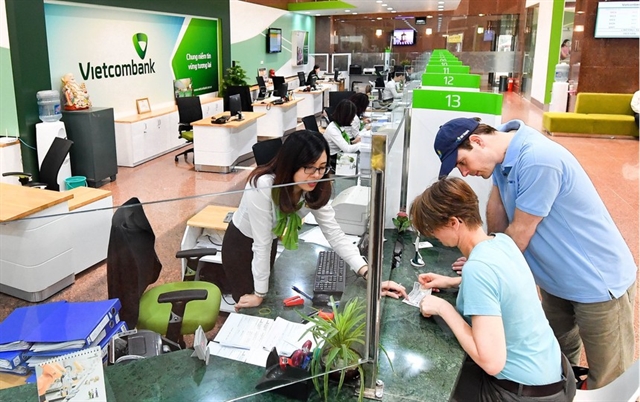With average price-to-earnings (P/E) and price-to-book (P/B) ratios at a five-year low, bank stocks are among the good options available for investors right now, analysts said.

With average price-to-earnings (P/E) and price-to-book (P/B) ratios at a five-year low, bank stocks are among the good options available for investors right now, analysts said.
According to Mirae Asset Vietnam Securities, average P/E and P/B ratios of the banking sector are 15.3 and 1.3, the lowest in five years.
The sector has moved in the same direction with the Vietnamese stock market’s benchmark VN-Index since the beginning of the year.
Between January 30 and March 23, both VN-Index and bank stocks were hit hard over worries about the socio-economic impact of the coronavirus pandemic COVID-19.
Bank stocks were once forecast to suffer from banks’ earnings as the virus spread which would see an increase in bad debt ratios, hike risk provisions and lower profits.
Banks were also asked to offer low interest lending packages to Vietnamese companies to help them cope with the effects of COVID-19.
These factors were the main causes for bank stocks’ sharp decline in the first quarter.
The heavyweight Vietcombank shares (VCB) lost as much as two-fifths in the first three-month period. Others such as Bank for Investment and Development of Vietnam (BID), Vietinbank (CTG) and Military Bank (MBB) shed as much as 44.5 per cent, 38 per cent and 40 per cent, respectively, in January-March.
The local market has bounced back strongly since early April, and bank stocks are still the driving factor.
Shares of Vietcombank, BIDV, Vietinbank and MBBank have gained substantially by 22.8-39.2 per cent since March end while the benchmark VN-Index has jumped nearly 30 per cent after bottoming at the three-year low of 660 points on March 24.
The worst scenarios for the pandemic have priced in local bank stocks and the current circumstance is not as bad as predicted, analysts have said.
Viet Nam has done well to contain the virus and it makes investors less doubtful about the economic growth prospects, Quan Trong Thanh, director of market analysis and institutional investors at Maybank Kim Eng Securities (MBKE), said.
“First-quarter earnings by banks are not too bad,” he said. “Banks are expecting their profits this year will fall a maximum of 10 per cent year-on-year and they are prepared for the rest of the year.”
Data at the South Korea-invested firm shows banks’ annual post-tax profit growth in 2020 may be at the three-year low of 3.4 per cent. Credit growth in the first three months was only 1.3 per cent, the lowest in six years.
Earnings may not increase sharply in the remaining months of the year as lending revenue falls, bad debt ratios rise and risk provisions are up to help local firms recover. In addition, economic and business activities will still be stagnant in the rest of the year.
“The worst time is perhaps over,” Le Quang Minh, director of market analysis at Mirae Asset Vietnam Securities, said.
“The disease is well-controlled, social distancing rules are loosened, and companies return to operation. Those will boost capital demand.”
The Government is doing its best to disburse economic stimulus solutions, including the loosening of monetary policies and enhancement of public investment, to boost consumption and investment, he said.
Besides, the central bank has committed to assuring the liquidity of the economy and kept cutting reference lending rates, encouraging banks to loan out at lower interest rates, Minh said.
On May 13, the State Bank of Vietnam made its third rate cut since September 2019. Saving rates were curbed to 0.2 per cent per annum for one-month term and 4.25 per cent per annum for one to six-month terms. Lending rates for prioritised sectors were also reduced.
Data provided by the central bank shows that at the end of April, banks had lowered their lending rates by 50-300 basis points for nearly 19 per cent of total loans. If the pandemic is completely controlled at the end of June, average lending rates will drop 40 basis points, Thanh at MBKE said.
In a recent report, VNDirect Securities Corporation (VNDS) said the six-year-low credit growth rate of 1.3 per cent in the first quarter was a big improvement from the credit growth of only 0.06 per cent recorded at the end of February.
“The Government's policies to support the economy, such as cutting policy rates, allowing the deferral of tax payments, and banks' support in the form of extending loan tenure, reducing and waiving interest obligations, have helped credit growth a bit,” the company said.
“The country's prompt response to the pandemic has helped to contain its spread, thereby reducing its impact on the economy.”
If the coronavirus is contained in June, so credit growth will pick up in the second half of the year, VNDS said. “We forecast credit growth for the year to reach 11 per cent.” — VNS





